- Photos and descriptions of more dealer modernization projects.
- Watch video interviews with Todd Kunau, Ron Ritchie and Leo Johnson discussing the highlights of their newly modernized dealerships.
For Todd Kunau, owner of Kunau Implement, a Case IH dealer with 2 stores in Iowa, modernizing his facilities at the Preston location had everything to do with staying relevant to their customers and being a dealership that will still be here in the future.
“If you’re not meeting the needs of your customers, how relevant will you be tomorrow? How important is growing and expanding to the life of the company? If we can sell the equipment but we can’t service it, how relevant are we?” asks Kunau.
For Johnson Tractor, its Janesville, Wis., store needed upgrades in a few different areas, which resulted in starting completely fresh with a new building. When the dealership opened in 1985, the precision farming department didn’t exist, but now 30 years later precision farming is a big piece of the dealership’s current and future revenue, and the department needed a designated area. Owner Leo Johnson says they also were interested in having a larger and more private office for human resources. And finally, like many dealers, Johnson says they simply needed a bigger and safer place to work on big equipment.
Modernizing the Shop
Kunau Implement began improving and rebuilding the service department and shop in June 2014 as the first phase of its renovation process. They removed smaller, outdated buildings on the dealership’s land that had been built to increase space over the years in the process.
Kunau added an indoor wash bay to the old primary shop and heated floors to the new shop to increase the comfort of the service technicians and also to give the dealership the ability to bring equipment in from outside in the winter to thaw out.
“In-floor heating puts the heat where the work is. Your feet are always warm, so you’re warm. It makes a big difference for our techs,” Kunau says.
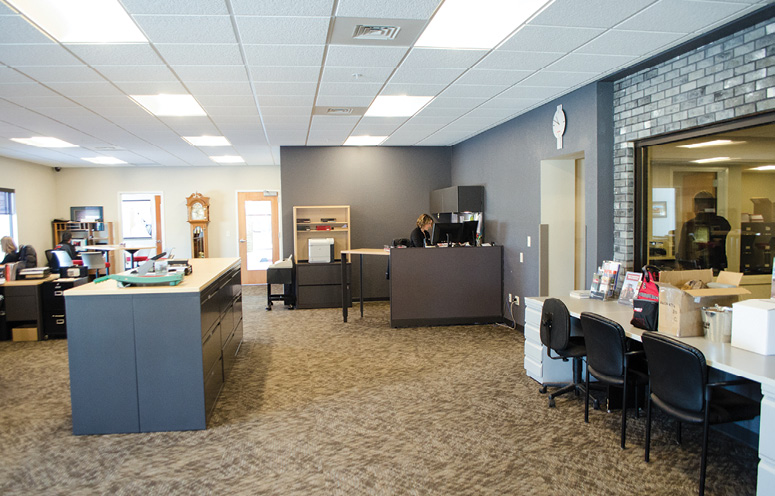
A large part of Ritchie Implement’s addition to its Cobb, Wis., location included expanding the work area for its bookkeeping department. The brick area shows where the outside wall of the old building was.
This is also useful for the service trucks and the dealership’s semi.
“They can bring the semi in overnight and with the in-floor heat, they can park it over the floor to drain and any snow or ice will be melted and dry by morning,” he says.
Ritchie Implement in Cobb, Wis., also updated its heating and cooling system when it added on to its shop. On the heating side, the dealership went with a geothermal system and the new shop has in-floor heating. Owner Ron Ritchie says the energy savings from going to geothermal have been impressive. “Our heating bill is hardly anything at all now,” he says.
The addition of air conditioning in the shop has done wonders for productivity. “You can get more out of a technician when they’re not soaking wet from sweat on a 90-degree day. We can keep it at 75 and the doors are shut in the summer if it’s 90 or 100 degrees. It’s just unbelievable how much more productivity you can get. And the attitude is just so much better,” says salesmen Tony Ritchie.
Johnson Tractor also added in-floor heat and air conditioning to the shop when it rebuilt its facility last year. “We wanted to create a good work environment in the shop. We didn’t want our technicians to have to stand on the cold concrete all winter. There are only a handful of days in the summer when we need the air conditioning, but those days when it’s 100 degrees, it’s not very productive, so we’re hoping to get a little more productivity now in the summer time,” Johnson says.
The need for space to work on bigger equipment drove Johnson to build a new 20,000-square foot shop with 6 bay doors. Red grid lines on the floor help technicians optimize the amount of equipment that can be in the shop at once. “We wanted to get the techs thinking when they bring something in, to use quadrants for lining it up rather than having everything kind of haphazard,” Johnson says.
LED lights in the shop at Kunau Implement increase visibility. “It’s like an operating room in the shop. It’s bright and there are no shadows. We have 40 fixtures and it gives it more daylight balance,” says Kunau.
To help with the shop lighting at Ritchie, they installed 6 overhead skylights that reflect the light around the room.
All three dealerships added overhead cranes to the shop, and all agree it’s been one of the most beneficial additions of their renovation projects.
Kunau says their Superior Crane Corp. crane has been used far more than anticipated. “I knew we’d use the crane, but I didn’t realize we’d use it many times every day,” he says. “I hoped it would be enough to justify spending the extra $150,000, but I think it’s really going to be a game changer for us.
“It used to be that we might have a crate on the floor and we would lift something out of the crate manually that you know you shouldn’t be lifting, but you’ll just do it because it’s easier than getting the forklift.
“With the crane in the new shop, they’re making better choices and getting the job done faster. The techs don’t have to ask someone to help them anymore, so where it used to take 2 man-hours, now it takes 15 minutes with one person and the crane,” Kunau says.
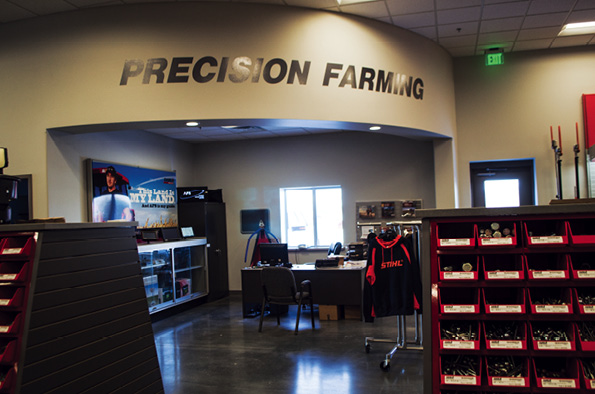
When Johnson Tractor’s original Janesville, Wis., location was built in 1985, precision farming wasn’t what it is today and as a result there wasn’t a designated area for the department as it became more prevalent. The new building has a precision farming sales area on the showroom floor.
Johnson Tractor also added two Superior Crane Corp. cranes to its shop, and Johnson agrees that it has made the shop safer and more productive. When one of the dealership’s best engine technicians injured a shoulder, the crane allowed him to come back to work sooner.
“He’s about 58 years old and he was working on something at home and he hurt his shoulder and had to have surgery. His recuperation time was long, but he didn’t want to miss work. At first we found some odd jobs for him to do, but eventually he went back to working on the engines. He had an engine out of a tractor and he ended up putting the engine back in this tractor one-handed. He had the remote for the crane in the one hand and he guided the engine over and inched it into place with the free hand. He says there’s no way he could have been back to work that soon without the use of the crane,” Johnson says.
When Ritchie Implement added on to its shop about 3 years ago, it added two Kone overhead cranes that run the full width of the shop. “We wanted to be able to lift a cab up, and that was a challenge. The building was built with the crane beams, so we didn’t have to put in separate beams. So it’s not an afterthought,” Ron Ritchie explains.
Ritchie’s shop addition about doubled its space. The old shop is now used almost exclusively for forage harvesters. “We’re working on choppers 12 months out of the year,” Ron Ritchie says.
Tony Ritchie sums up the reasons to update the shop saying, “If customers want quality service, they need to have a quality dealership.”
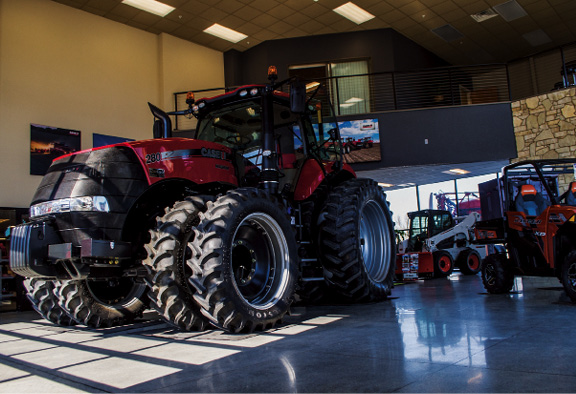
When Ritchie Implement expanded its building, it was limited in how far out it could build. So, the dealership built up and the new facility includes a two-story expo area that is large enough to fit a combine. It also has a second floor classroom that overlooks the expo floor.
Organized Parts
The second phase of Kunau Implement’s renovation, was completed this past December and was designed to centralize the parts department. Before the renovation, Kunau says parts were scattered in different areas across the facility. With the renovation, Kunau now has one parts department where all of the dealership’s parts are stored.
The new parts department is located centrally in between the shop and the showroom, and has two counters, one for the service technicians in the shop and one facing the showroom for customers.
“All of the parts are going into the center of the facility now, so we’re central to the parts counter going into the shop and the parts counter going out into the showroom. Just consolidating parts should give us a better workflow and higher efficiency,” he says.
Johnson Tractor also brought most of its parts storage under one roof with the renovation. The dealership now has a customer-facing service counter in the show room, as well, which helps them better promote their services.
“Half the time when a farmer comes to talk to you it’s lousy weather because they can’t do anything else. If they come in and it’s pouring rain, it’s a lot easier to look at this tractor inside…” — Ron Ritchie
“Customers don’t have to go through some doors and down a hallway just to find a service clerk or manager now. Our service counter faces the showroom and is more customer oriented. The flow is better. It’s really nice to just have everything under one roof now,” Johnson says.
With the new building, Johnson took the opportunity to reconfigure the parts counter. “Our other locations just have a single long parts counter that all the parts employees work at. Here, we set up workstations. Two of them are individual and one is a double, with the theory being that we put our rookie and our veteran in the double together so they can learn from each other.”
Updated Showroom
Ritchie Implement’s most recent project was adding on to the front end of the facility, expanding its showroom and the office space. In all, an additional 7,300 square feet was added on. This part of the project was completed a year ago. With the new design, the sales offices line the perimeter of the showroom. “We like to have all our sales offices in the open where everyone can see. That’s always been a pet peeve of mine in the different dealerships that I’ve bought. I always like to have an office where when a guy walks in the door, I can see who’s walking in,” Ron Ritchie says. “I don’t get to see as many people as I like because I can’t get out there all the time, but they can at least see me and I can wave at them and recognize them. It’s an important design that allows us to greet the customer.”
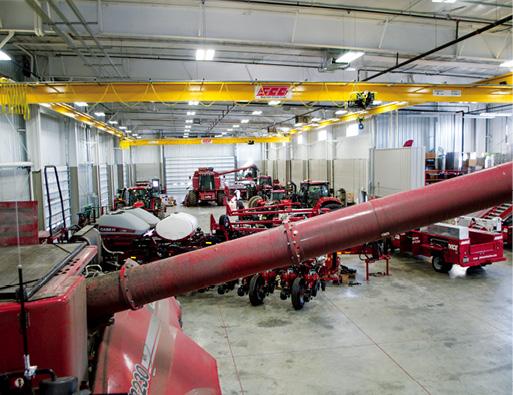
Adding two overhead cranes to the service department at Johnson Tractor has increased productivity in the shop by turning 2-person jobs that could take an hour into a job one tech can do in half the time.
Ritchie added on a 2-story exhibition area that can accommodate larger equipment like combines and choppers. “It’s not just limited to a tractor. We made sure you could back a combine in with an auger sticking out the back,” says Tony Ritchie.
“It’s nice to do walk arounds in the winter or if it’s raining. Half the time when a farmer comes to talk to you it’s lousy weather because they can’t do anything else,” Ron Ritchie says. “If they come in and it’s pouring rain, it’s a lot easier to look at this tractor inside.”
Ritchie rotates the equipment on display about every week. And, if they know a customer is coming in to see a specific piece of equipment, they’ll bring it inside ahead of time. “I don’t want to stand outside and neither do they,” Ron Ritchie says.
Johnson Tractor added a 60 x 60 foot exhibition room as well, which Johnson says is their favorite new feature in the dealership. The room stands off from the showroom as a separate space so they can heat or cool the large space as needed, but don’t have to constantly heat it in the winter, saving money on their energy bill.
Like Ritchie, Johnson says the best feature of the room is that it functions as an indoor sales area. “We sell used combines 12 months of the year and if we know there is a customer coming to look at one, we’ll jump in it and move it into the expo room. We let it melt and the customer can then walk around it and comfortably talk with the salesperson. The salespeople aren’t competing with the noise of a shop in the expo room or the elements from outside. It’s difficult to spend time with a customer in 10-degree weather and our salespeople have really come to depend on the space.
“One day, a salesman drove 4 skid loaders into the expo room for a prospect to view. The salesman turned it into a shopping event between models, rather than shopping between dealers, thanks to the expo room.”
In addition, the expo room is used to hold clinics, community events and even the company Christmas party. “We’ve already used it for probably a half dozen events. Sprayer clinics, tractor clinics, etc. It cleans up to be a really nice room and letting non-profit and farmer groups use it brings different people into the dealership.”
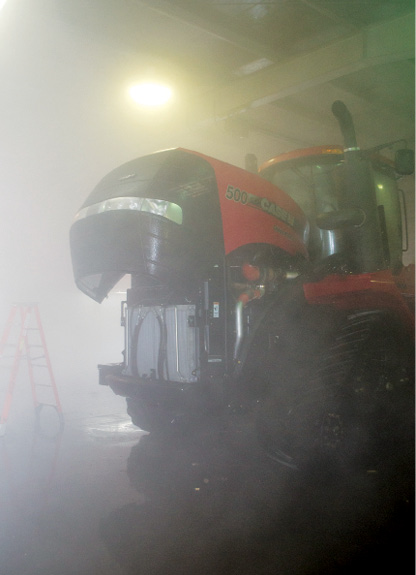
When Kunau Implement in Preston, Iowa, built its new service shop, it converted part of the existing shop into a wash bay.
Ritchie Implement also uses its space to hold clinics. Above their exhibition area is a classroom/meeting room area that overlooks the show floor. The Ritchies say this has been particularly useful during walk arounds when they hold clinics. The second floor room was designed to function as a classroom during clinics, a boardroom and a general meeting room. The tables are all on wheels so they can be rearranged depending on what the room is being used for. For example, during a board meeting or sales meeting, the tables will be arranged in a U shape. But for a classroom, the tables are set in rows. The room is equipped with a big screen TV, replacing the projector that was used previously, and Wi-Fi. It also has a small kitchen attached to it.
“We just had a service meeting up here 2 weeks ago with the service departments from all three stores. We’re planning to bring them all together at least three times a year to strategize what we can do to make our shops more efficient. So, we use this room for everything. It’s not just sales. We have Case IH come to us now instead of always having to go down to Racine. We’ve had other dealers like Johnson Tractor and Service Motor meet here with Case as well,” explains Tony Ritchie.
Expanding Office Space
One of Johnson Tractor’s main reasons for rebuilding its facility, which was finished in early December, was to add offices and a dedicated HR office. When the facility was first built in 1985, the location only had 12 employees. Over the last 30 years, the location has grown to about 40 employees and the dealership was running out of room.
Finding the Payback in Improving Facilities, Growing Staff
During his presentation at the 2015 Dealership Minds Summit, Mike Hedge, president/CEO of Birkey’s Farm Store (15-store locations), Champaign, Ill., spoke about the impact of creating additional space for the aftermarket business.
When service managers are short on headcounts, they have a tendency to take on less work. And while they like to think they can do the same work by keeping techs more productive, this almost never happens, Hedge says.
“We don’t want to overlook the potential to increase our service revenues. In many cases, we’re limited both by the quantity and quality of our service shop space,” he says.
Birkey’s has expanded a number of its shops over the last 10 years. In doing so, Hedge says they’ve typically found that by adding a couple of additional technicians, the payback on the investment happens fairly quickly.
One technician can generate approximately $150,000 of labor sales and can generate combined gross margin from parts and service of about $150,000, explains Hedge. “If we can add two technicians, we can generate about $300,000 of additional gross margin a year and we can usually create some efficiencies for existing staff that results in improved productivity.
“We do all of our administrative functions out of the Janesville location, so we needed to get bigger to include more offices. Without an HR office in the old facility, employees had to ask for time off for personal or family matters in front of everyone, which no one wants,” Johnson says.
They also had to make room for their precision farming department. “Twenty or 30 years ago, we had no idea what precision farming was all about. Of course now we have dedicated precision farming employees and we had to make room and offices for them as well,” he says.
Ritchie’s expansion also included new office space for the accounting, precision farming and warranty departments. Previously, the book keeping department was all in a small crowded area. Now, they are in an area three to four times the size of their old workspace. The precision farming and warranty departments are now in this same area, as well. The room has open workstations as well as a high-top table for the sales team to use if they need to go over paperwork with someone in accounting. CFO Connie Ritchie’s office is also now right by the rest of the department.
Outdoor Staging Area
Another new feature of the new Preston location for Kunau is the addition of an outdoor service staging area with 10 receptacles and 20-foot cords hard wired into the receptacles.
“Before we added the staging area, we’d use a utility vehicle with a generator in it and we’d drive it to our holding area,” Kunau says.
“If we can sell the equipment but we can’t service it, how relevant are we?” — Todd Kunau
“Now we can just plug the equipment in at the staging area. This time of year, it’s always ready to go. The customer can leave the equipment outside and we’ll warm it up and bring it inside when we’re ready.
“We still have jobs sitting outside. In really cold weather, we can plug the equipment in without getting the generator out. Whatever piece of equipment is going in next, we move into that area to warm up. We’re constantly shifting,” he says.
If Only We Had Help...
If one thing could have been done differently, Connie Ritchie says she would have liked it if they had started completely new. Ritchie’s rural lifestyle and outdoor motor sports store is located next door, and Ritchie says, in retrospect, it may have been easier to have built new on the other side of town. That store is next on Ritchie Implement’s list to renovate.
Johnson says he wishes he had spent more time researching the heating and air conditioning system he used in the facility. “I am not entirely satisfied with the amount of noise generated by one of the big furnaces up front. I should have used more furnaces instead of one really large one with electronic zones.”
Kunau recommends that dealers who are expanding their facility budget for the unexpected add-ons and problems that may come up during construction. Kunau Implement had to add a 500 foot storm drain to the new section of their facility to combat a water run-off problem made worse during the construction.


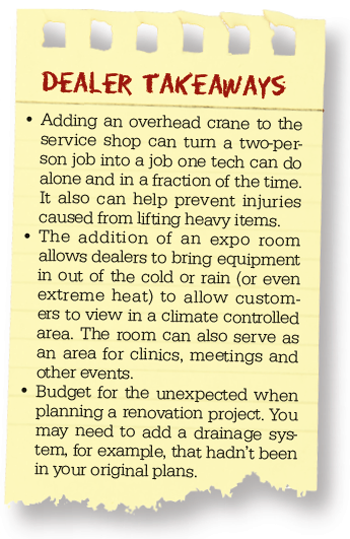







Post a comment
Report Abusive Comment